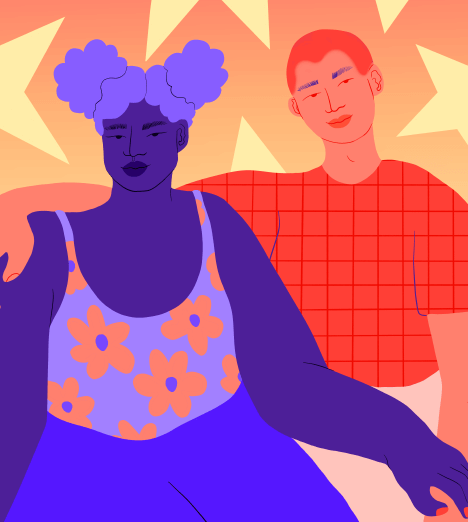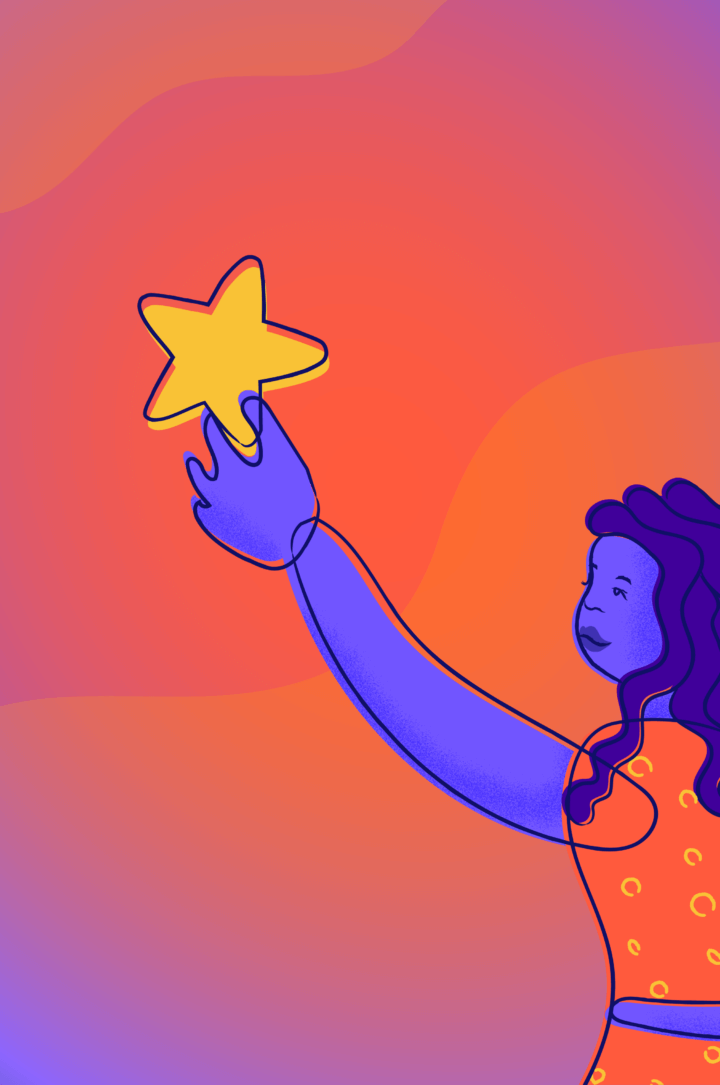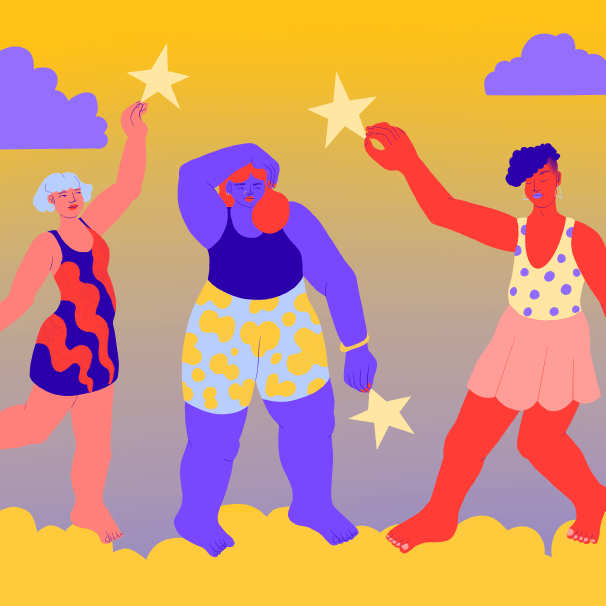Bisexual is just one of the many non-binary sexual orientations out there.
What is bisexuality?
Bisexuality is a sexual orientation, and bisexual (commonly abbreviated to “bi”) people are those who have the capacity to form attraction and/or relationships to more than one gender. Bisexual advocate Robyn Ochs’ popular definition of bisexuality is, “The potential to be attracted — romantically and/or sexually — to people of more than one sex and/or gender, not necessarily at the same time, not necessarily in the same way, and not necessarily to the same degree.” Bisexual people make up a significant portion of queer young people. According to the Centers for Disease Control and Prevention’s Youth Risk Behavior Survey, bisexual people comprise 75% of young people who identify as lesbian, gay, or bisexual. Remember, people of any gender can identify as bisexual or be attracted to more than one gender.
Is bisexuality binary?
Some argue that bisexuality reinforces the gender binary because the prefix bi- in bisexual comes from the Greek prefix for “two.” Many words that describe sexuality were originally rooted in the gender binary, due to limited understandings of gender at the time by larger society. (For example: “heterosexuality” has the prefix hetero- which comes from Greek, meaning “the other of two; different.”) However, the historical and cultural definition of the term bisexual has always referred to more than one gender, and the current definition is not specifically binary. Identity definitions are not just literal. They are a part of our ever-evolving language that reflects the diversity of the people using these words.
What is the difference between bisexuality and pansexuality?
Some people use the word pansexual to describe their attraction to more than one gender. Pansexuality is defined as an attraction to people of any gender or to people regardless of their gender, with the prefix pan- coming from the Greek prefix for “all.” Some people may use the words bisexual and pansexual interchangeably, and others use only one word exclusively to describe themselves. It’s important to ask what words a person would like to use to describe themselves, rather than assuming or defining for other people. There is no “better” identity term, there is only the best identity term for you.
Other ways to identify
The Trevor Project’s 2019 National Survey on LGBTQ+ Youth Mental Health found that respondents used more than 100 different terms to label their sexuality! Identities like omnisexual, abrosexual, and skoliosexual may also describe a form of attraction to more than one gender, though these identities are not necessarily synonymous or interchangeable with the word bisexual.
Multisexuality refers to all identities that include romantic and/or sexual attraction to people of more than one gender. This is in contrast to monosexuality, which is defined as identities involving attraction to people of a single gender, such as exclusively gay or straight identities. Multisexual identities include:
- Queer refers to an identity that expands outside of heterosexuality. Due to its history as a reclaimed slur and use in political movements, queer still holds political significance.
- Pansexual is an identity term for romantic and/or sexual attraction to people regardless of gender identity or to people of all genders. For some pansexual people, gender is not a defining characteristic of the attraction they feel to others. Other pansexual folks may feel that gender is a significant part of their experience of attraction.
- Omnisexual refers to someone who is attracted to people of all genders, and for whom gender plays an important part of attraction.
- Abrosexual describes one’s sexual attraction that is fluid and constantly changing.
- Skoliosexual is a term that refers to attraction to trans and nonbinary people.
- Fluid refers to someone who experiences changes in their sexual attraction over time and/or depending on the situation. Some people may find that who they are attracted to and/or the intensity of those feelings change over different days or depending on who they are in a relationship with. Remember, while sexuality can be fluid, attempts to forcibly change a person’s sexuality, such as with the discredited practice of conversion therapy, are harmful and ineffective.
Some multisexual people use more than one of these labels. People may share different labels for their identities depending on the context or who they are speaking to. For example, a person may define themselves as bisexual to a relative who is unfamiliar with LGBTQ+ identities, but further specify their identity as fluid or pansexual when talking to friends within the queer and trans community. Other people may use one label exclusively no matter who they are speaking with. It’s OK to use one label or multiple labels for your identity.
Bisexuality & romantic orientations
LGBTQ+ youth are finding more expansive ways than ever to describe their attraction, including when it comes to defining their romantic orientation. These terms are important for asexual (or ace) people who experience little to no sexual attraction. Many asexual people desire romantic relationships, and romantic orientations are a way for aces to communicate who they prefer to date or form relationships with. You may hear some asexual people define their orientation with terms like biromantic or panromantic. LGBTQ+ young people who do not identify as asexual may use romantic orientations to clarify the nuances of their orientation as well. Whether your attraction to more than one gender is sexual or romantic, you are welcome in the bi community.
Do we need labels?
Labels can be a huge source of self-understanding for some LGBTQ+ people. Because we live in a society where everyone is assumed and expected to be straight and cisgender, finding the words to define yourself can be an act of liberation. Labels can help connect people to one another, allowing them to feel less alone and to create community together. Labels also allow researchers to study marginalized groups, giving us important information to better understand and support these groups.
While labels feel meaningful for some LGBTQ+ people, labels can feel restrictive for others. It’s OK to explore different labels or to avoid labels altogether! You are never required to label your identity in a particular way or to disclose your identity, especially if doing so would compromise your safety.
Why it’s important to support bisexual youth
While all LGBTQ+ young people are at a higher risk of experiencing negative mental health outcomes than their heterosexual and cisgender peers, it’s worth noting that bisexual youth statistically face more challenges than lesbian and gay youth as well. According to The Trevor Project’s research on the mental health of bisexual young people, almost half of bisexual youth seriously considered suicide in the past year. 66% of bisexual youth reported feeling sad or hopeless for two or more weeks in a row in the past year, compared to 27% of their heterosexual peers and 49% of their gay/lesbian peers. Additionally, more than one in three bisexual youth reported being bullied at school, and one in five bisexual youth reported being forced to have sexual intercourse. These outcomes for harassment, sexual assault, and rape are particularly severe for bisexual people as compared to their straight, gay, and lesbian peers.
These statistics underscore the need to increase public understanding and support for bisexual youth. They also remind us that no matter what words we use to describe an attraction to more than one gender, as a whole, this group faces significant obstacles and unique challenges. We must do more to make the world a safer place for bisexual young people.
Frequently Asked Questions About Bisexuality
Question 1: I finally came out to my parents/friends, but everyone has been telling me that being bisexual isn’t real, that I will grow out of it, or that it’s just a phase. But it’s not a phase. This is who I am! How can I help them understand?
Answer: Coming out to your family and friends is a really brave step! That isn’t easy, and it can be even more difficult when it seems like you weren’t heard or accepted. Bisexuality is a real identity, and you’re never too young to know how you feel. If you know that you’re bisexual, then no one can tell you otherwise! Unfortunately, you can’t control how everyone reacts to your news. It’s possible that even if your family and friends heard you, they might not be ready to understand what you’re saying. It might help to give them some resources, like Bisexuality 101. The Trevor Project also has a great resource for coming out for anyone who chooses to do so.
Question 2: My mom says bisexuals are more promiscuous and have more STDs. Is this true?
Answer: Anyone who does not practice safer sex is at a heightened risk for STIs and STDs, but that applies to all people who are engaging in sexual activities. Liking more than one gender does not mean that you’ll automatically be more sexually active. After all, our sexual orientation does not determine our behavior. It’s a myth that all bisexual people are promiscuous. The reality is that bisexual people could fall anywhere on the sexuality spectrum, from asexual or biromantic (have little to no sexual attraction to others, at all) to very sexual and physical. Also, just because someone is attracted to men and women does not mean they will be unfaithful to their partner, and or be with both men and women at all times. A bisexual person could be monogamous (have only one partner) or be polyamorous (have multiple partners) – just like someone who is straight, gay, lesbian, pan, etc. The combinations are endless, and that is totally ok!
Question 3: Isn’t everyone a little bisexual?
Answer: Human sexuality is a really complicated, personal topic. There are so many different ways to identify, and the only person who can tell us how we feel is ourselves. When we suggest that everyone is at least a little bit attracted to more than one gender, we’re taking away people’s freedom to express who they truly like. Also, most bisexual people have put a great deal of thought into understanding their sexual orientation and it’s not fair to minimize their experience by saying that “everyone” is probably bi. Instead, we want to empower all people to identify in the way that fits them the best.
Question 4: Do you have to be equally attracted to men and women to be bisexual?
Answer: A person who is bisexual does not have to be equally attracted to more than one gender identity. In fact, most bisexuals don’t experience attraction in a 50/50 split. It is very common for bisexual people to prefer one gender over another, and some say that this preference changes over time. Some bisexual people feel romantic feelings towards one gender but physical attraction towards others. Only you can identify what you’re feeling. It’s important to remember, though, that there is no rush. Take as much time as you need to determine what makes the most sense for you.
Question 5: Do I need to come out as bisexual if I don’t have a partner of the same gender?
Answer: It is perfectly normal to feel unsure or worried about coming out. The question of whether or not you should come out is one that only you yourself can answer. Coming out has lots of positives; it can let people in your life know about an important part of you, it can help you to feel less alone, meet new friends as well as possibly meet people to date.
There are some questions that you could ask yourself when deciding whether to come out. If you do decide to come out, who would be the first person you would come out to? What would be the best case scenario for coming out? What would be the worst? Is there a possibility that things may go wrong if you come out and, if there is a chance, do you have a back-up plan? If there is a chance that coming out may put you at any sort of risk or endanger your ability to continue living at home, you may want to wait to come out until you are more independent.
Remember, it is your choice to come out and you do not have to come out to everybody in your life at once. You can choose who you want to come out to and when. You can also choose not to come out to certain people in your life. The choice is completely yours. Trevor supports you no matter what.
Question 6: I am really only attracted to men, but there is this one lady that I have a huge crush on. I have always thought of myself as straight, but does this mean I am bisexual?
Answer: How you identify is completely up to you! If straight feels like the label that fits you best, then no one can tell you otherwise. If you feel like bisexual fits you better these days, then that is completely okay too. Even if neither of these labels fit, or starts to change over time, don’t worry – that is perfectly normal. You can label yourself, or not, in whatever way you see fit!
Question 7: I have never hooked up with a boy EVER, so how do I know if I am really bisexual?
Answer: A person doesn’t need to have a physical experience with someone else to understand who they’re attracted to. In fact, sexual orientation describes way more than physical attraction – it includes our romantic, emotional, mental, and/or spiritual attraction to other people, too. Think about the crushes you’ve had, and who you fantasize about being with: girls, boys, both, or maybe other genders or sexes that don’t fit into the binary. Remember bisexual people do not need to have had equal sexual experiences with both men and women. It’s all up to how you feel – and if identifying as bisexual sounds right to you, then go for it!
Additional Resources for Understanding & Supporting Bisexual People
- Bisexual.org
- Bisexual Resource Center
- glaad – Bisexual
- LGBT Foundation – Coming out as bisexual
- HRC – A Resource Guide to Coming Out as Bisexual
- Planned Parenthood – Sexual Orientation
Through The Trevor Support Center you are able to link to other websites which are not under the control of The Trevor Project. The Trevor Project does not review or ensure the accuracy of the content on other sites.
Help us continue to provide 24/7 support to LGBTQ+ young people and empower allies to deepen their commitment through advocacy, education, and affirming content.


